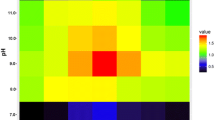Summary
The archaebacterium Halobacterium halobium contains two related gas vacuole protein-encoding genes (vac). One of these genes encodes a protein of 76 amino acids and resides on the major plasmid. The second gene is located on the chromosome in a (G+C)-rich DNA fraction and encodes a slightly larger but highly homologous protein consisting of 79 amino acids. The plasmid encoded vac gene is transcribed constitutively throughout the growth cycle while the chromosomal vac gene is expressed during the stationary phase of growth. Comparison of the nucleotide sequences of the two genes indicates differences in the putative promoter regions as well as 35 single base-pair exchanges within the coding regions of the two genes. The majority of the nucleotide exchanges in the coding region occur in the third position of a codon triplet generating the codon synonym. The only differences between the two encoded proteins are the exchange of 2 amino acids (positions 8 and 29) and a deletion of 3 amino acids near the carboxy-terminus of the plasmid encoded vac protein. The genomic DNAs from other halobacterial isolates (Halobacterium sp. SB3, GN101 and YC819-9) were found to contain only a chromosomal vac gene copy. There is a high conservation of the chromosomal vac gene and the genomic region surrounding it among the halobacterial strains investigated.
Similar content being viewed by others
References
Betlach M, Pfeifer F, Friedman J, Boyer HW (1983) Bacterio-opsin mutants of Halobacterium halobium. Proc Natl Acad Sci USA 80:1416–1420
Bünemann H, Müller W (1978) Base-specific fractionation of double stranded DNA: Affinity chromatography on a novel type of adsorbant. Nucleic Acids Res 5:1059–1074
Chirgwin JM, Przybyla AE, MacDonald RJ, Rutter W (1979) Isolation of biologically active ribonucleic acid from sources enriched in ribonuclease. Biochemistry 18:5294–5299
DasSarma S, Damerval T, Jones JG, Tandeau de Marsac N (1987) A plasmid-encoded gas vesicle protein gene in a halophilic archaebacterium. Mol Microbiol 1:365–370
Devereux J, Haberli P, Smithies O (1984) A comprehensive set of sequence analysis programs for the VAX. Nucleic Acids Res 12:387–395
Ebert K, Goebel W, Pfeifer F (1984) Homologies between heterogeneous extrachromosomal DNA populations of Halobacterium halobium and four new halobacterial isolates. Mol Gen Genet 200:311–332
Feinberg AP, Vogelstein B (1983) A technique for radiolabelling DNA restriction endonuclease fragments to high specific activity. Anal Biochem 132:6–13
Kuhn I, Stephenson F, Boyer HW, Greene P (1986) Positive selection vectors using lethality of the EcoRI endonuclease. Gene 44:234–263
Maniatis T, Fritsch EF, Sambrook J (1982) Molecular cloning, a laboratory manual. Cold Spring Harbor Laboratory Press, Cold Spring Harbor Laboratory, New York
Pfeifer F (1986) Insertion elements and genome organization of Halobacterium halobium. Syst Appl Microbiol 7:36–40
Pfeifer F, Betlach M (1985) Genome organization in Halobacterium halobium: A 70kb island of more (AT) rich DNA in the chromosome. Mol Gen Genet 198:449–455
Pfeifer F, Weidinger G, Goebel W (1981) Genetic variability in Halobacterium halobium. J Bacteriol 145:375–381
Sanger F, Nicklen S, Coulson HR (1977) DNA sequencing with chain terminating inhibitors. Proc Natl Acad Sci USA 74:5463–5467
Simon R (1981) Morphology and protein composition of gas vesicles from wild type and gas vacuole deficient strains of Halobacterium salinarium strain 5. J Gen Microbiol 125:103–111
Southern EM (1975) Detection of specific sequences among DNA fragments separated by gel electrophoresis. J Mol Biol 98:503–517
Staden R (1980) A new computer method of the storage and manipulation of DNA gel reading data. Nucleic Acids Res 8:3673–3694
Surek B (1987) Proteinchemische und genetische Untersuchungen sprechen für das Vorliegen von zwei unterschiedlichen Gasvakuolenproteinen in Halobakterien. PhD thesis, University of Würzburg, FRG
Tandeau de Marsac N, Mazal D, Bryant D, Houmard J (1985) Molecular cloning and nucleotide sequence of a developmentally regulated gene from the cyanobacterium Calothrix PCC7601: a gas vesicle gene. Nucleic Acids Res 13:7223–7239
Walker JE, Hayes PK, Walsby AE (1984) Homology of gas vesicle proteins in cyanobacteria and halobacteria. J Gen Microbiol 130:2709–2715
Author information
Authors and Affiliations
Additional information
Communicated by W. Arber
Rights and permissions
About this article
Cite this article
Horne, M., Englert, C. & Pfeifer, F. Two genes encoding gas vacuole proteins in Halobacterium halobium . Mol Gen Genet 213, 459–464 (1988). https://doi.org/10.1007/BF00339616
Received:
Issue Date:
DOI: https://doi.org/10.1007/BF00339616




